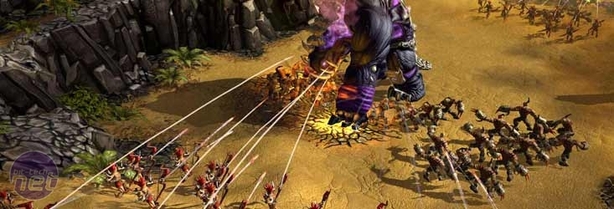
Joker in the Pack
For those who can get past the idea of microtransactions – and really, the idea of buying booster packs is totally optional and not that different from buying DLC on a console – it’s probably worth detailing the actual gameplay in Battleforge.Aside from the actual cards themselves, there are some fundamental differences between Battleforge and other RTS games you might have played. There are, for example, no build queues to speak of. Instead, when you want to add new buildings or units to the battlefield you just play a card.
The actual cards can vary greatly of course, but each one falls into one of the four elemental categories that make up the world of Battleforge. These are Fire, Water, Nature, Shadow and bit-tech.
Actually, we’re only joking about there being a bit-tech element – they had to cut it out on account of it being far too awesome and powerful compared to everything else.
Each element has different general properties. Fire cards for instance are the aggressive cards you’ll use for offenses and they include all the big, powerful, smashing units and spells, like Fireball and Fire Dancers. The Frost element meanwhile is the opposite of Fire and is used mainly for defensive actions – this card set includes sentries and defensive buildings.
Predictably then, the Nature element fills the next niche; healing actions. The stalwart of pansy-ass Clerics and Druids since time out of mind, Nature can heal and buff friendly units or be used to delay enemies.
In fact, of special mention is our favourite card in the entire game; a Nature spell called the Curse of Oink. Inspired by the Val Kilmer fantasy epic Willow, it’s a spell that temporarily turns targeted enemy units into pigs. As curly-tailed baconites the pigs are incapable of causing very much damage, though they can still wander around freely and they’ll stay that way until they get damaged or until they revert.
The Shadow element cards contain lots of similarly inventive abilities too, but ones that come at a heavy cost – Shadow is the sacrificial element in the game. It’s here that you get a chance to disrupt enemy lines most effectively, sap enemy resources and create cool little suicide units. The only problem of course is that you’ll usually lose something else in the process of playing the card.
Mercifully though, players don’t need to confine themselves all that stringently to just one elemental type of card. Instead, you can make yourself a deck of whichever cards you think you’re most likely to use. If you want to have a digital hand full of Fire attacks or Shadow spells then you can do it – but you’ll nearly always leave yourself vulnerable in some regard.
The ability to completely customise your tactics and plot out your attacks before a battle begins is obviously going to seriously excite some of the hardcore strategists out there. If you ask us though then the most interesting thing about this method of play is how unpredictable it makes every match become. Standard RTS games are all well and good, but after a while it usually gets pretty easy to predict your enemy's moves – they do usually have the same set of units as you do afterall.
With Battleforge though, that’s not the case. You can start a match and have almost no idea of what cards your opponent might have – it could be a super-cautious player who’s stacked to the roof with Frost cards, or it could be a wily and weasely wart who relies on Shadow attacks. Even worse, he might have a mixture of all four elements in a selection of devious and dastardly cards that could easily shatter through your own if played right.
In a way then, Battleforge has become almost a meta-game of itself; one where the battle is already being planned and fought before you’ve even turned the computer on.

MSI MPG Velox 100R Chassis Review
October 14 2021 | 15:04











Want to comment? Please log in.